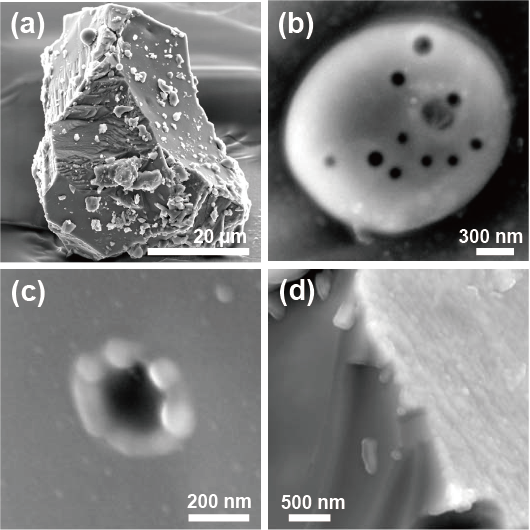Space environment of an asteroid preserved on micrograins returned by the Hayabusa spacecraft
Asteroids are intermediate products of the growth of planetary bodies. As observed on the Moon, surfaces of airless bodies retain accumulated histories of solid-to-solid interactions. Meteorites that fall to Earth are fragments of asteroids; however, entry into Earth's atmosphere erases much of the evidence of the processes affecting their surfaces in space environment. For this reason, observations regarding the surfaces of low-gravity celestial bodies have been limited to those obtained remotely. In this study, we examined microscopic grains collected from the outermost surface of an asteroid called 25143 Itokawa and returned to Earth by the Hayabusa spacecraft. Comprehensive analysis including nanometer-scale study in terrestrial laboratory provides a glimpse of the physically and chemically processed asteroid surface resulting from a long history of micrometeorite impacts.
This paper reports a summary of initial analysis of the sizes, morphology, mineralogy, and geochemistry of five lithic grains returned from the asteroid Itokawa as a part of the Hayabusa mission. The grains are 4010 μm-sized and consist of single or multiple mineral phases. The chemical properties of these grains were examined utilizing electron- and ion-beam techniques. For chemical analyses, each grain was cut into three slabs and the middle slab was analyzed. Oxygen isotope compositions, useful to trace the sources of solar matter, confirmed that the grains cannot be terrestrial in origin and are derived from the asteroid. Considering this O isotope evidence, and also the major-element compositions of the grains, we concluded that the building blocks of the asteroid were equilibrated ordinary chondrites, the most abundant type of meteorite falling to Earth.
Description of the grain surfaces was by scanning electron microscopy with 10 nm resolution (Figure 1a). Surfaces of the grains retain textures obtained in the space environment and are dominated by fractures containing sub-μm-sized craters and adhered objects. The observation suggests the importance, at the asteroid surface, of the destruction of lithic materials by external forces such as repeated impacts. The occurrence of sub-μm-scale craters (10000 nm in diameter, Figure 1b) is direct evidence of bombardment by nm-scale, high-velocity projectiles. The adhered objects, with a typical size of 1 牛, are another prominent features of the grain surfaces. It is likely that they are fragments of other grains on the Itokawa surface. Most of these objects have sub-rounded or flake-like shapes and are composed of phases observed on the host grains. They are attached on grain surfaces with unknown bonding agents. Some of the objects have sub-rounded shapes suggesting that they approached the surface with significant velocity before solidification (Figure 1c). Assuming blackbody thermal radiation, residence time for the melts is estimated to be 10 s; therefore, the melting occurred within meters of the adhesion sites. We also observed a scaly fabric that can be considered a result of space erosion (Figure 1d).
Planetary bodies are believed to have accreted from dust and debris in the early solar nebula, involving repeated impacts of smaller objects and related aggregation into growing planetary embryos. Prior to the sample return by Hayabusa, it was not possible to examine the products of such processes directly. By analyzing the surfaces of tiny grains delivered by this spacecraft, evidence of the bombardment of solids, down to 10 nm scales, has been revealed. A proto-Itokawa asteroid tens of km in diameter was fragmented during a very long collisional history, resulting in the current 100-m-scale Itokawa with complex surface textures. Although asteroids appear to float peacefully in space, their shapes and sizes and surface features can reflect hostile collision-related processes, at scales of 10 to 104 m spatial scales and time-scales of up to 109 years. Further surface observations on grains returned by Hayabusa will add statistical significance to the insights regarding solid-to-solid interactions fundamental to our understanding of asteroid accretion and, more broadly, the formation and evolution of interplanetary objects in space environment. (28, Feb., 2012).

References:
- Nakamura, E., Makishima, A., Moriguti, T., Kobayashi, K., Tanaka, R., Kunihiro, T., Tsujimori, T., Sakaguchi, C., Kitagawa, H., Ota, T., Yachi, Y., Yada, T., Abe, M., Fujimura, A., Ueno, M., Mukai, T., Yoshikawa, M., Kawaguchi, J., Space environment of an asteroid preserved on micrograins returned by the Hayabusa spacecraft, PNAS Plus, 109(11), E624–E629, 2012. doi:10.1073/pnas.1116236109, dream/20120224095412-627-620